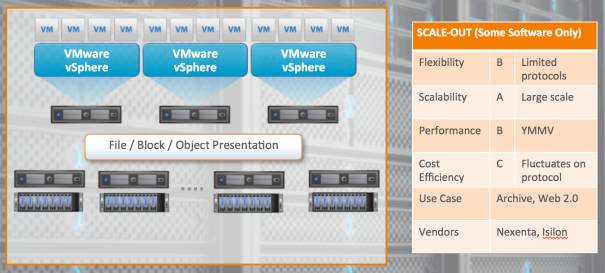This is the third of six posts (the last one was Scale-up Software-Only “SDS”) where we’re going to cover some practical details that help raise your SDS IQ and enable you to select the SDS solution that will deliver Storage on Your Terms. The third SDS flavor in our series is Scale-out.
Scale-out is a fundamentally different approach from scale-up; with Scale-out, multiple head nodes can be attached over the network to dramatically increase scalability. This is a broad category, and solutions for it could be either vendor-defined / hardware based (think EMC’s Isilon), or software-only (Nexenta’s NexentaEdge); while we’d consider the software-only approach to be the SDS version, the technical benefits of either type of scale out are similar. You use low-latency networking to connect as many nodes as you want and form a cluster that provides storage services out to applications as unified name space.
The scale-out approach works well for Archive or Web 2.0 applications use cases. Scalability is top notch, because you can start small and grow just by adding nodes. While it provides the performance needed to handle huge capacities, there’s an important dependence on the network – the quality of your gear will significantly impact performance, because of the amount of communication between nodes; that may mean that your IOPS aren’t great
The flexibility of scale-out SDS is generally good but currently offers limited protocol support. Often the maturity of the platforms themselves limits your flexibility; for example, you can’t use Exchange to write to an object back end. Likewise, object-oriented applications won’t work with some back ends, either. Protocol support considerations also impact the cost effectiveness of Scale-out: they may restrict your hardware choices and lock you in to more expensive purchases.
Overall grade: B
See below for a typical build and the report card:

